Understanding the Chemical Composition and Biological Activities of Different Extracts of Secamone afzelii Leaves: A Potential Source of Bioactive Compounds for the Food Industry
Abstract
1. Introduction
2. Results and Discussion
2.1. Total Phenolics and Flavonoids Content
2.2. HPLC-ESI-MSn Analysis
2.3. Quantification of Phytochemicals
2.4. Antioxidant Capacity
2.5. Enzyme Inhibitory Effects
2.6. Molecular Dynamic Studies of Quercitrin with Tyrosinase
3. Materials and Methods
3.1. Plant Materials and Preparation of Extracts
3.2. Chromatographic Analysis
3.3. Determination of Total Phenolic, Flavonoid and Antioxidant, and Enzyme Inhibitory Effects
3.4. In Silico Experiments
3.4.1. Enzyme Preparation
3.4.2. Ligands Preparation
3.4.3. Molecular Docking
3.4.4. Molecular Dynamic
3.4.5. MD trajectory Analysis
3.4.6. Enzyme Structure Conformational Mobility and Stability Analysis
4. Conclusions
Author Contributions
Funding
Institutional Review Board Statement
Informed Consent Statement
Data Availability Statement
Acknowledgments
Conflicts of Interest
Sample Availability
References
- Newman, D.J.; Cragg, G.M. Natural products as sources of new drugs over the nearly four decades from 01/1981 to 09/2019. J. Nat. Prod. 2020, 83, 770–803. [Google Scholar] [CrossRef] [PubMed]
- Samtiya, M.; Aluko, R.E.; Dhewa, T.; Moreno-Rojas, J.M. Potential health benefits of plant food-derived bioactive components: An overview. Foods 2021, 10, 839. [Google Scholar] [CrossRef]
- Galanakis, C.M. Functionality of food components and emerging technologies. Foods 2021, 10, 128. [Google Scholar] [CrossRef] [PubMed]
- Michiels, J.A.; Kevers, C.; Pincemail, J.; Defraigne, J.O.; Dommes, J. Extraction conditions can greatly influence antioxidant capacity assays in plant food matrices. Food Chem. 2012, 130, 986–993. [Google Scholar] [CrossRef]
- Do, Q.D.; Angkawijaya, A.E.; Tran-Nguyen, P.L.; Huynh, L.H.; Soetaredjo, F.E.; Ismadji, S.; Ju, Y.-H. Effect of extraction solvent on total phenol content, total flavonoid content, and antioxidant activity of Limnophila aromatica. J. Food Drug Anal. 2014, 22, 296–302. [Google Scholar] [CrossRef] [PubMed]
- Mohammed, E.A.; Abdalla, I.G.; Alfawaz, M.A.; Mohammed, M.A.; Al Maiman, S.A.; Osman, M.A.; Yagoub, A.E.A.; Hassan, A.B. Effects of Extraction Solvents on the Total Phenolic Content, Total Flavonoid Content, and Antioxidant Activity in the Aerial Part of Root Vegetables. Agriculture 2022, 12, 1820. [Google Scholar] [CrossRef]
- Filly, A.; Fabiano-Tixier, A.S.; Louis, C.; Fernandez, X.; Chemat, F. Water as a green solvent combined with different techniques for extraction of essential oil from lavender flowers. C. R. Chim. 2016, 19, 707–717. [Google Scholar] [CrossRef]
- Abere, T.A.; Onwukaeme, D.N. Pharmacognostic evaluation of the leaves of Secamone afzelii (Schult) K Schum (Asclepiadaceae). Trop. J. Pharm. Res. 2012, 11, 125–131. [Google Scholar] [CrossRef]
- Taiwo, O.O.; Ayoka, A.O.; Akano, O.P.; Adeoye, A.D.; Odukoya, S.O.A. Effects of Ethanol Extract of Secamone afzelii (Schult) K. Schum (Asclepiadceae) Leaves on Aluminum Chloride-induced Reproductive Toxicity in Male Wistar Rats. J. Krishna Inst. Med. Sci. 2021, 10, 55–66. [Google Scholar]
- Watt, J.M.; Breyer-Brandwijk, M.G. The Medicinal and Poisonous Plants of Southern and Eastern Africa; E & S Livingstone Ltd.: Edinburgh, UK; London, UK, 1962; p. 1224. [Google Scholar]
- Dickson, R.A.; Amponsah, I.K.; Annan, K.; Fleischer, T.C. Nutritive potential of a polyherbal preparation from some selected Ghanaian herbs. J. Nat. Prod. Plant Resour. 2014, 4, 77–81. [Google Scholar]
- Mensah, A.; Houghton, P.; Akyirem, G.; Fleischer, T.; Mensah, M.; Sarpong, K.; Adosraku, R. Evaluation of the antioxidant and free radical scavenging properties of Secamone afzelii Rhoem. Phytother. Res. 2004, 18, 1031–1032. [Google Scholar] [CrossRef] [PubMed]
- Houghton, P.; Hylands, P.; Mensah, A.; Hensel, A.; Deters, A. In vitro tests and ethnopharmacological investigations: Wound healing as an example. J. Ethnopharmacol. 2005, 100, 100–107. [Google Scholar] [CrossRef] [PubMed]
- Adesina, J.; Ofuya, T.; Afolabi, L. Insecticidal activity of Secamone afzelii (Schult) K. Schum powder in the control of Stiphilous zeamais (Mots) (Coleoptera: Curculionidae). J. Agric. Tech. 2012, 8, 117–124. [Google Scholar]
- Mensah, A.; Mireku, E.; Okwuonu, V. Anti-inflammatory and anti-oxidant activities of Secamone afzelii (Rhoem) Ascleipiadaceae. J. Med. Biomed. Sci. 2014, 3, 23–30. [Google Scholar] [CrossRef]
- Zabri, H.; Kodjo, C.; Benie, A.; Bekro, J.M.; Bekro, Y. Phytochemical screening and determination of flavonoids in Secamone afzelii (Asclepiadaceae) extracts. Afr. J. Pure Appl. Chem. 2008, 2, 80–82. [Google Scholar]
- Magid, A.A.; Yao-Kouassi, P.A.; Gossan, D.P.A.; Mairot, C.; Voutquenne-Nazabadioko, L. New antioxidant flavonoids from the aerial parts of Secamone afzelii. J. Antioxid. Act. 2016, 1, 8. [Google Scholar]
- Verardo, G.; Duse, I.; Callea, A. Analysis of underivatized oligosaccharides by liquid chromatography/electrospray ionization tandem mass spectrometry with post-column addition of formic acid. Rapid Commun. Mass Spectrom. Int. J. Devoted Rapid Dissem. Up—Minute Res. Mass Spectrom. 2009, 23, 1607–1618. [Google Scholar] [CrossRef]
- Sun, J.; Liu, X.; Yang, T.; Slovin, J.; Chen, P. Profiling polyphenols of two diploid strawberry (Fragaria vesca) inbred lines using UHPLC-HRMSn. Food Chem. 2014, 146, 289–298. [Google Scholar] [CrossRef]
- Spínola, V.; Llorent-Martínez, E.J.; Gouveia, S.; Castilho, P.C. Myrica faya: A new source of antioxidant phytochemicals. J. Agric. Food Chem. 2014, 62, 9722–9735. [Google Scholar] [CrossRef]
- Biba, O.; Strnad, M.; Gruz, J. Analytical approaches for kaempferol determination. Chem. Phys. Res. J. 2013, 6, 305. [Google Scholar]
- Iloki-Assanga, S.B.; Lewis-Luján, L.M.; Lara-Espinoza, C.L.; Gil-Salido, A.A.; Fernandez-Angulo, D.; Rubio-Pino, J.L.; Haines, D.D. Solvent effects on phytochemical constituent profiles and antioxidant activities, using four different extraction formulations for analysis of Bucida buceras L. and Phoradendron californicum. BMC Res. Notes 2015, 8, 396. [Google Scholar] [CrossRef]
- Yu, M.; Gouvinhas, I.; Rocha, J.; Barros, A.I. Phytochemical and antioxidant analysis of medicinal and food plants towards bioactive food and pharmaceutical resources. Sci. Rep. 2021, 11, 10041. [Google Scholar] [CrossRef] [PubMed]
- Hussain, Z.; Yagi, S.; Mahomoodally, M.; Mohammed, I.; Zengin, G. A comparative study of different solvents and extraction techniques on the anti-oxidant and enzyme inhibitory activities of Adansonia digitata L. (Baobab) fruit pulp. South Afr. J. Bot. 2019, 126, 207–213. [Google Scholar] [CrossRef]
- Abu, T.; Ogbole, O.; Ajaiyeoba, E. Radical Scavenging Activity, Brine Shrimp Lethality Assay and HPLC Analysis of Methanol Extracts of Secamone afzelii. Niger. J. Pharm. Res. 2021, 17, 233–244. [Google Scholar] [CrossRef]
- Zheng, W.; Wang, S.Y. Antioxidant activity and phenolic compounds in selected herbs. J. Agric. Food Chem. 2001, 49, 5165–5170. [Google Scholar] [CrossRef] [PubMed]
- Jimoh, F.; Adedapo, A.; Afolayan, A. Comparison of the nutritional value and biological activities of the acetone, methanol and water extracts of the leaves of Solanum nigrum and Leonotis leonorus. Food Chem. Toxicol. 2010, 48, 964–971. [Google Scholar] [CrossRef]
- Sánchez-Moreno, C. Methods used to evaluate the free radical scavenging activity in foods and biological systems. Food Sci. Technol. Int. 2002, 8, 121–137. [Google Scholar] [CrossRef]
- Jung, H.A.; Woo, J.J.; Jung, M.J.; Hwang, G.-S.; Choi, J.S. Kaempferol glycosides with antioxidant activity from Brassica juncea. Arch. Pharmacal Res. 2009, 32, 1379–1384. [Google Scholar] [CrossRef]
- Yagi, S.; Drouart, N.; Bourgaud, F.; Henry, M.; Chapleur, Y.; Laurain-Mattar, D. Antioxidant and antiglycation properties of Hydnora johannis roots. S. Afr. J. Bot. 2013, 84, 124–127. [Google Scholar] [CrossRef]
- Urbaniak, A.; Kujawski, J.; Czaja, K.; Szelag, M. Antioxidant properties of several caffeic acid derivatives: A theoretical study. C. R. Chim. 2017, 20, 1072–1082. [Google Scholar] [CrossRef]
- Dalar, A.; Uzun, Y.; Mukemre, M.; Turker, M.; Konczak, I. Centaurea karduchorum Boiss. from Eastern Anatolia: Phenolic composition, antioxidant and enzyme inhibitory activities. J. Herb. Med. 2015, 5, 211–216. [Google Scholar] [CrossRef]
- Proença, C.; Freitas, M.; Ribeiro, D.; Tomé, S.M.; Oliveira, E.F.; Viegas, M.F.; Araújo, A.N.; Ramos, M.J.; Silva, A.M.; Fernandes, P.A. Evaluation of a flavonoids library for inhibition of pancreatic α-amylase towards a structure–activity relationship. J. Enzym. Inhib. Med. Chem. 2019, 34, 577–588. [Google Scholar] [CrossRef]
- Olennikov, D.N.; Kashchenko, N.I.; Chirikova, N.K.; Akobirshoeva, A.; Zilfikarov, I.N.; Vennos, C. Isorhamnetin and quercetin derivatives as anti-acetylcholinesterase principles of marigold (Calendula officinalis) flowers and preparations. Int. J. Mol. Sci. 2017, 18, 1685. [Google Scholar] [CrossRef]
- El-Nashar, H.A.; El-Din, M.I.G.; Hritcu, L.; Eldahshan, O.A. Insights on the inhibitory power of flavonoids on tyrosinase activity: A survey from 2016 to 2021. Molecules 2021, 26, 7546. [Google Scholar] [CrossRef]
- Habtemariam, S. α-Glucosidase inhibitory activity of kaempferol-3-O-rutinoside. Nat. Prod. Commun. 2011, 6, 1934578X1100600211. [Google Scholar] [CrossRef]
- Lee, D.; Park, J.Y.; Lee, S.; Kang, K.S. In vitro studies to assess the α-glucosidase inhibitory activity and insulin secretion effect of isorhamnetin 3-o-glucoside and quercetin 3-o-glucoside isolated from Salicornia herbacea. Processes 2021, 9, 483. [Google Scholar] [CrossRef]
- Harris, Z.; Donovan, M.G.; Branco, G.M.; Limesand, K.H.; Burd, R. Quercetin as an emerging anti-melanoma agent: A four-focus area therapeutic development strategy. Front. Nutr. 2016, 3, 48. [Google Scholar] [CrossRef]
- Fernández-Poyatos, M.d.P.; Ruiz-Medina, A.; Zengin, G.; Llorent-Martínez, E.J. Phenolic characterization, antioxidant activity, and enzyme inhibitory properties of Berberis thunbergii DC. leaves: A valuable source of phenolic acids. Molecules 2019, 24, 4171. [Google Scholar] [CrossRef] [PubMed]
- Grochowski, D.M.; Uysal, S.; Aktumsek, A.; Granica, S.; Zengin, G.; Ceylan, R.; Locatelli, M.; Tomczyk, M. In vitro enzyme inhibitory properties, antioxidant activities, and phytochemical profile of Potentilla thuringiaca. Phytochem. Lett. 2017, 20, 365–372. [Google Scholar] [CrossRef]
- Uysal, S.; Zengin, G.; Locatelli, M.; Bahadori, M.B.; Mocan, A.; Bellagamba, G.; De Luca, E.; Mollica, A.; Aktumsek, A. Cytotoxic and enzyme inhibitory potential of two Potentilla species (P. speciosa L. and P. reptans Willd.) and their chemical composition. Front. Pharmacol. 2017, 8, 290. [Google Scholar] [CrossRef] [PubMed]
- Ismaya, W.T.; Rozeboom, H.J.; Weijn, A.; Mes, J.J.; Fusetti, F.; Wichers, H.J.; Dijkstra, B.W. Crystal structure of Agaricus bisporus mushroom tyrosinase: Identity of the tetramer subunits and interaction with tropolone. Biochemistry 2011, 50, 5477–5486. [Google Scholar] [CrossRef]
- Maestro, Maestro 3: Schrödinger Suite 2021-3 Lig Prep; Schrödinger LLC: New York, NY, USA, 2021.
- Lu, C.; Wu, C.; Ghoreishi, D.; Chen, W.; Wang, L.; Damm, W.; Ross, G.A.; Dahlgren, M.K.; Russell, E.; Von Bargen, C.D.; et al. OPLS4: Improving Force Field Accuracy on Challenging Regimes of Chemical Space. J. Chem. Theory Comput. 2021, 17, 4291–4300. [Google Scholar] [CrossRef] [PubMed]
- Mollica, A.; Costante, R.; Akdemir, A.; Carradori, S.; Stefanucci, A.; Macedonio, G.; Ceruso, M.; Supuran, C.T. Exploring new Probenecid-based carbonic anhydrase inhibitors: Synthesis, biological evaluation and docking studies. Bioorg. Med. Chem. 2015, 23, 5311–5318. [Google Scholar] [CrossRef]
- Fawzi Mahomoodally, M.; Mollica, A.; Stefanucci, A.; Zakariyyah Aumeeruddy, M.; Poorneeka, R.; Zengin, G. Volatile components, pharmacological profile, and computational studies of essential oil from Aegle marmelos (Bael) leaves: A functional approach. Ind. Crops Prod. 2018, 126, 13–21. [Google Scholar] [CrossRef]
- Zengin, G.; Rodrigues, M.J.; Abdallah, H.H.; Custodio, L.; Stefanucci, A.; Aumeeruddy, M.Z.; Mollica, A.; Rengasamy, K.R.R.; Mahomoodally, M.F. Combination of phenolic profiles, pharmacological properties and in silico studies to provide new insights on Silene salsuginea from Turkey. Comput. Biol. Chem. 2018, 77, 178–186. [Google Scholar] [CrossRef]
- Schrödinger Release, Schrödinger Release, 2021–1: Maestro; Schrödinger LLC: New York, NY, USA, 2021.
- Guo, Z.; Mohanty, U.; Noehre, J.; Sawyer, T.K.; Sherman, W.; Krilov, G. Probing the α-helical structural stability of stapled p53 peptides: Molecular dynamics simulations and analysis. Chem. Biol. Drug Des. 2010, 75, 348–359. [Google Scholar] [CrossRef]
- Jorgensen, W.L.; Chandrasekhar, J.; Madura, J.D.; Impey, R.W.; Klein, M.L. Comparison of simple potential functions for simulating liquid water. J. Chem. Phys. 1983, 79, 926–935. [Google Scholar] [CrossRef]
- Kaminski, G.A.; Friesner, R.A.; Tirado-Rives, J.; Jorgensen, W.L. Evaluation and reparametrization of the OPLS-AA force field for proteins via comparison with accurate quantum chemical calculations on peptides. J. Phys. Chem. B 2001, 105, 6474–6487. [Google Scholar] [CrossRef]
- Shivakumar, D.; Williams, J.; Wu, Y.; Damm, W.; Shelley, J.; Sherman, W. Prediction of absolute solvation free energies using molecular dynamics free energy perturbation and the OPLS force field. J. Chem. Theory Comput. 2010, 6, 1509–1519. [Google Scholar] [CrossRef] [PubMed]
- Nosé, S. A unified formulation of the constant temperature molecular dynamics methods. J. Chem. Phys. 1984, 81, 511–519. [Google Scholar] [CrossRef]

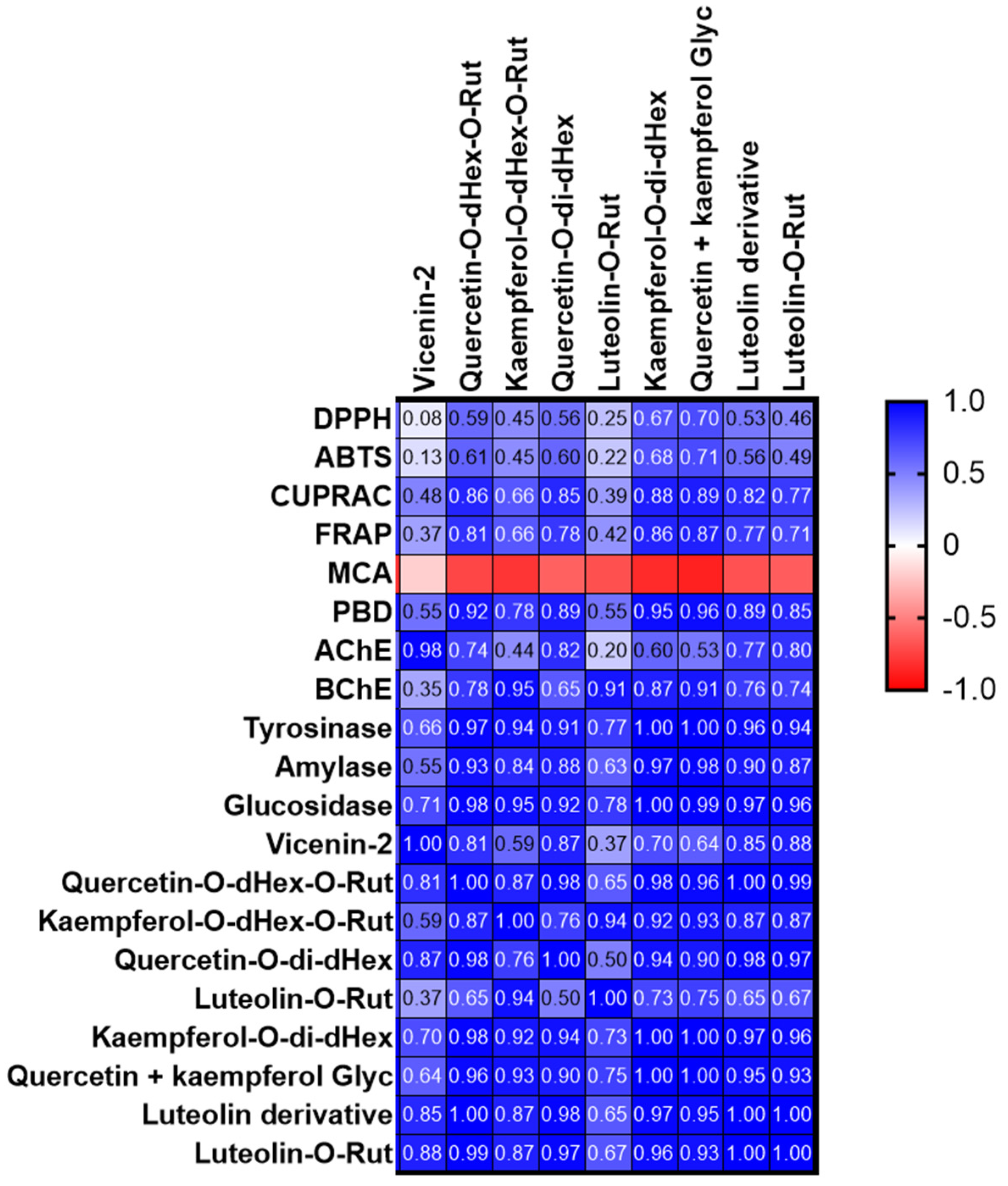
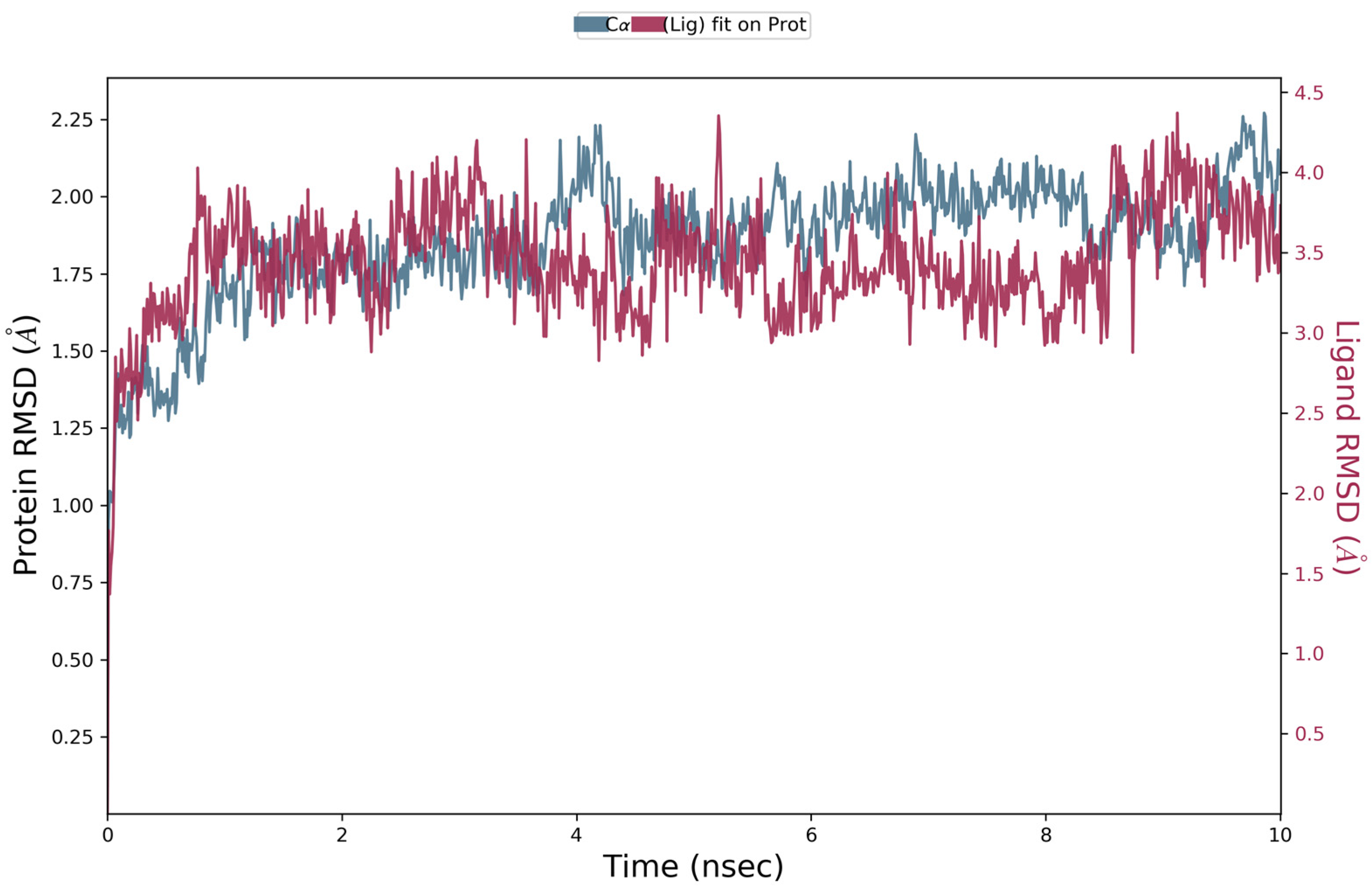
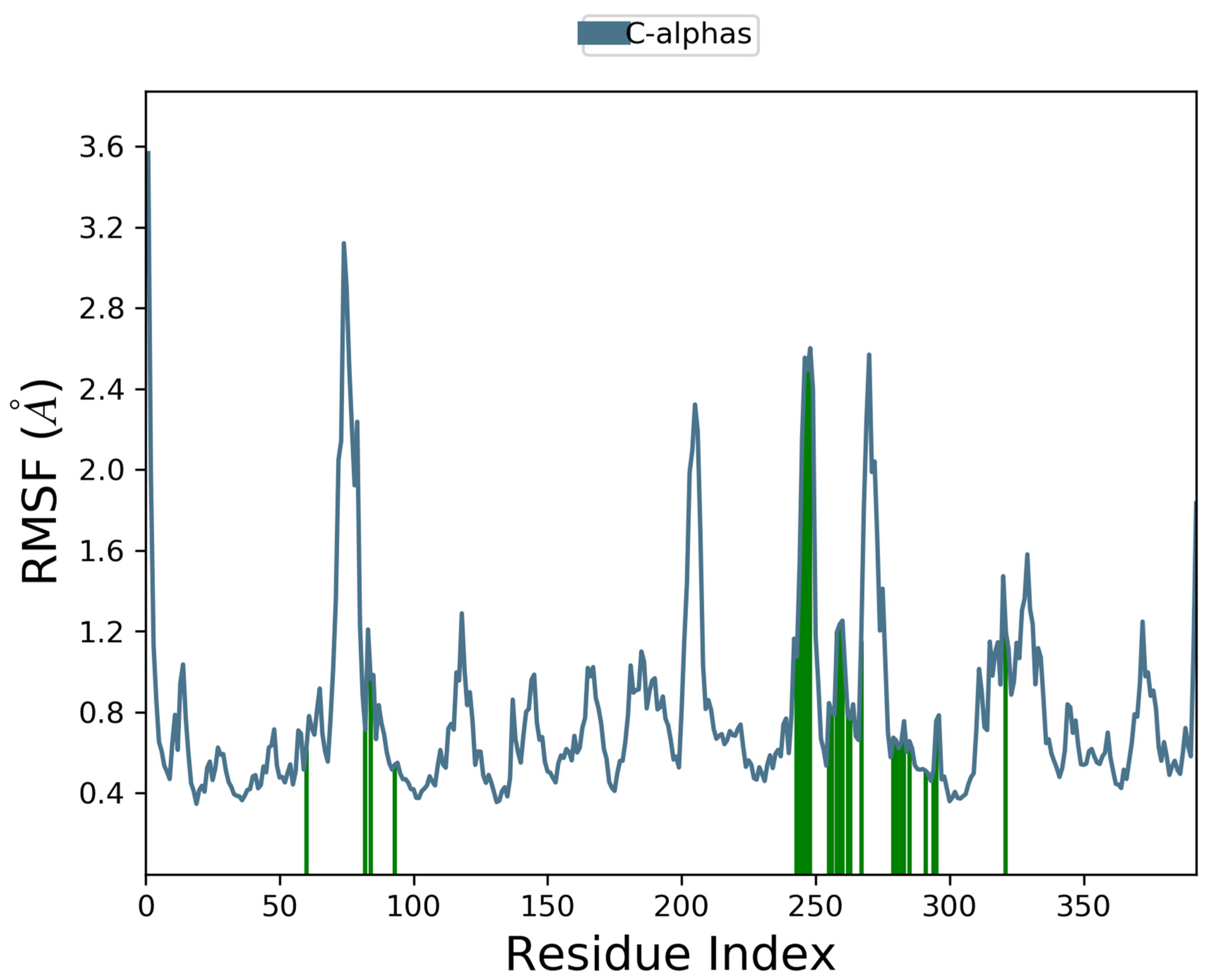
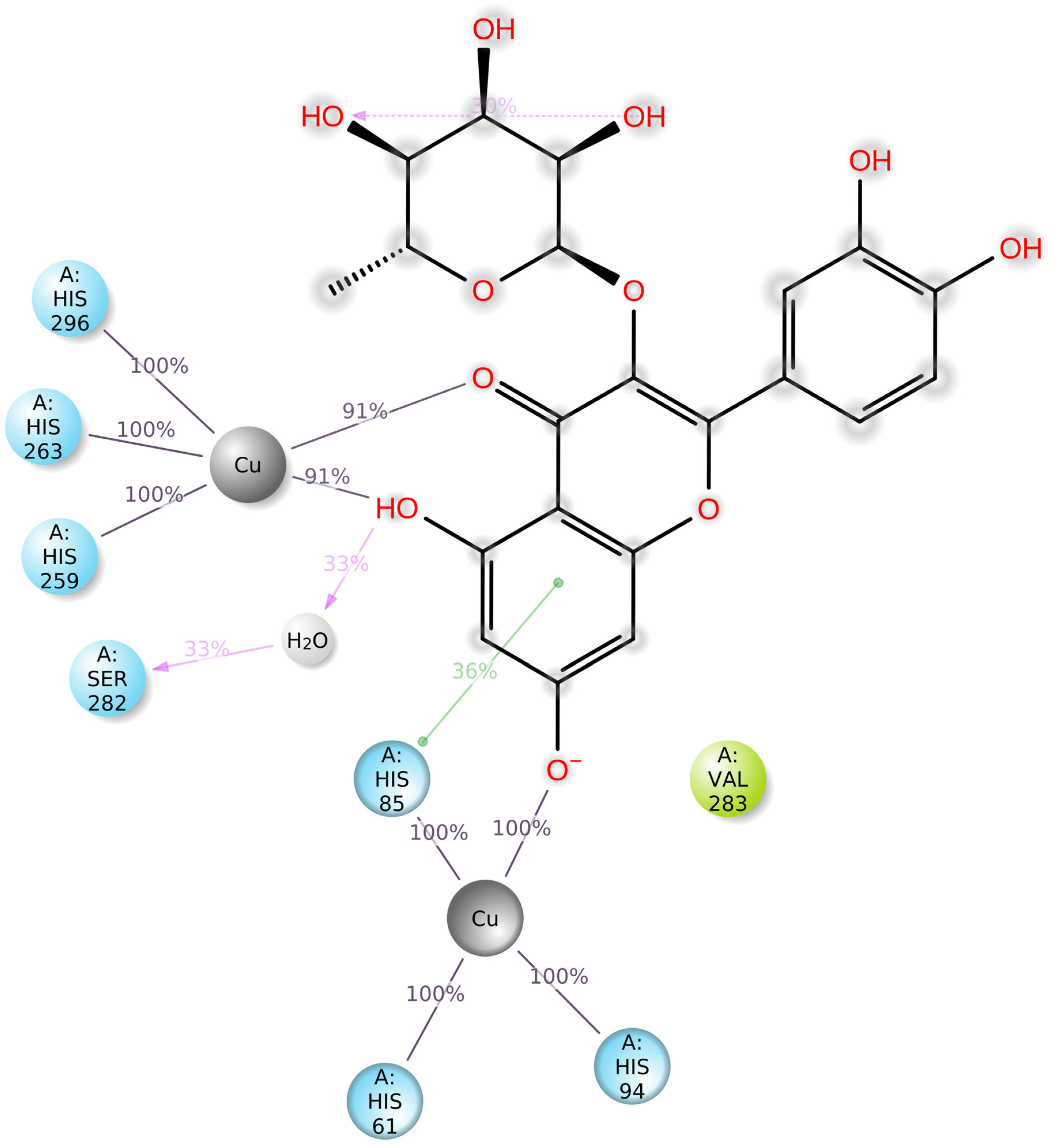
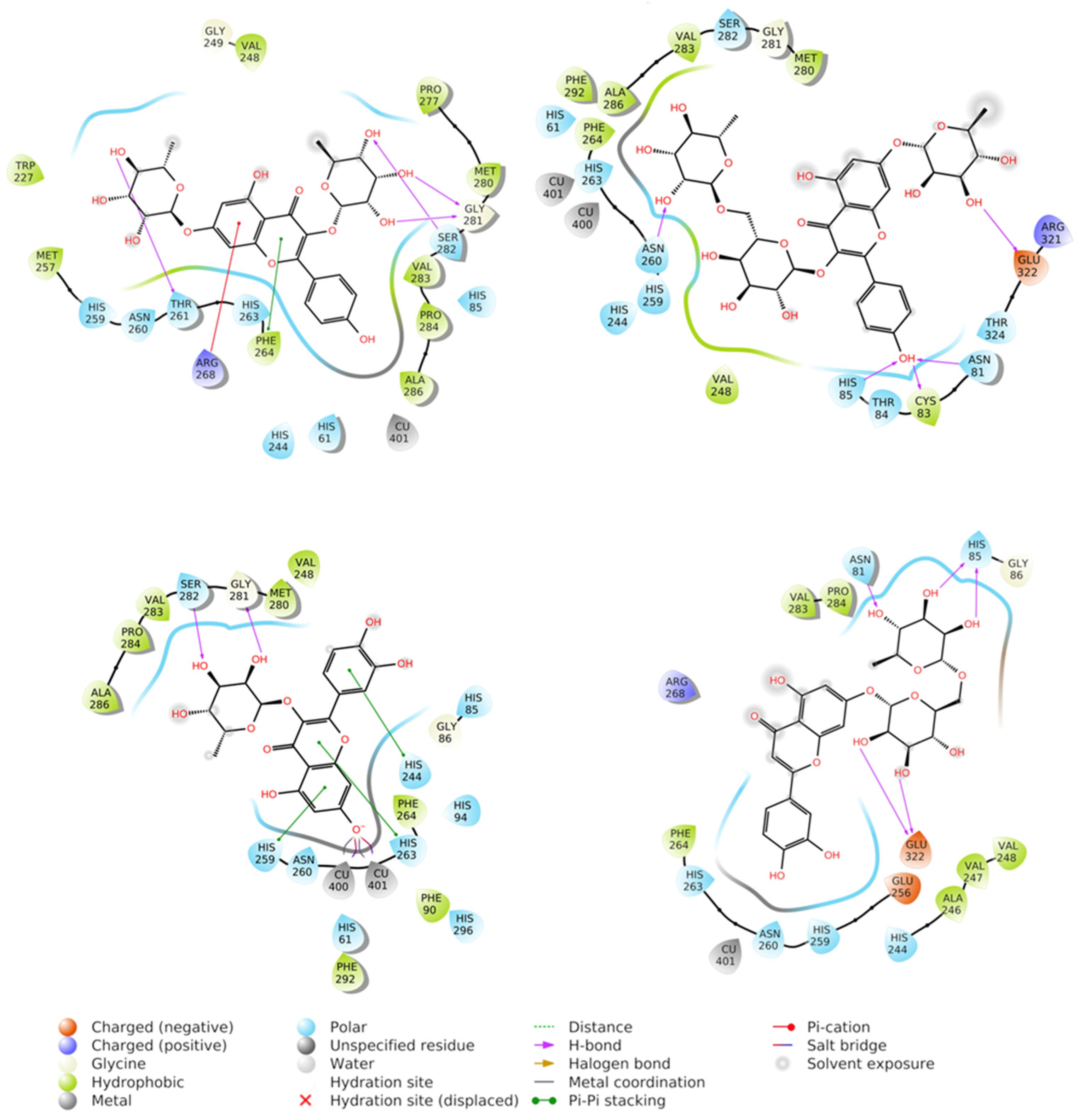
| Extracts | Total Phenolic Content (mg GAE/g) | Total Flavanoid Content (mg RE/g) |
|---|---|---|
| Methanol (50%) | 62.91 ± 1.90 b | 17.29 ± 0.15 c |
| Methanol (80%) | 81.69 ± 0.50 a | 26.63 ± 0.26 b |
| Methanol (100%) | 82.79 ± 0.90 a | 29.96 ± 0.45 a |
| Water | 25.42 ± 0.38 c | 11.45 ± 0.06 d |
| No. | tR (min) | [M-H]− m/z | m/z (% Base Peak) | Assigned Identification | MeOH | 80% MeOH | 50% MeOH | H2O |
|---|---|---|---|---|---|---|---|---|
| 1 | 1.8 | 377 | MS2 [377]: 341 (100) MS3 [377→341]: 179 (100), 161 (18), 143 (22), 131 (9), 113 (19) | Disaccharide (HCl adduct) | ✓ | ✓ | ✓ | |
| 2 | 1.9 | 191 | MS2 [191]: 173 (29), 111 (100) | Isocitric acid | ✓ | ✓ | ✓ | ✓ |
| 3 | 2.7 | 191 | MS2 [191]: 173 (24), 111 (100) | Citric acid | ✓ | ✓ | ✓ | ✓ |
| 4 | 3.7 | 315 | MS2 [315]: 153 (100), 109 (14) | Dihydroxybenzoic acid-O-hexoside | ✓ | ✓ | ✓ | ✓ |
| 5 | 4.6 | 305 | MS2 [305]: 179 (100) MS3 [305→179]: 135 (100) | Caffeic acid derivative | ✓ | ✓ | ✓ | |
| 6 | 5.8 | 203 | MS2 [203]: 186 (3), 159 (100), 142 (13) MS3 [203→159]: 130 (96), 116 (100) | Tryptophan | ✓ | ✓ | ✓ | ✓ |
| 7 | 6.0 | 901 | MS2 [901]: 781 (69), 739 (100) | Unknown | ✓ | |||
| 8 | 6.9 | 577 | MS2 [577]: 451 (32), 425 (100), 407 (65), 289 (29), 287 (20) | Procyanidin | ✓ | ✓ | ✓ | |
| 9 | 8.1 | 577 | MS2 [577]: 451 (14), 425 (100), 407 (73), 289 (22), 287 (16) | Procyanidin | ✓ | ✓ | ✓ | |
| 10 | 8.8 | 289 | MS2 [289]: 245 (100), 205 (37), 203 (25) | Catechin | ✓ | ✓ | ✓ | |
| 11 | 10.7 | 431 | MS2 [431]: 385 (100), 223 (13), 153 (9) | Roseoside (formate adduct) | ✓ | ✓ | ✓ | |
| 12 | 12.9 | 593 | MS2 [593]: 503 (22), 473 (100), 383 (26), 353 (37) | Apigenin-6,8-di-C-glucoside (vicenin-2) | ✓ | ✓ | ✓ | ✓ |
| 13 | 13.9 | 593 | MS2 [593]: 473 (100), 431 (98), 351 (64), 327 (91), 285 (66) MS3 [593→431]: 285 (100) MS4 [593→431→285]: 255 (100), 151 (7) | Kaempferol-C-hexoside-O-deoxyhexoside | ✓ | |||
| 14 | 15.3 | 593 | MS2 [593]: 447 (41), 431 (76), 285 (100) MS3 [593→431]: 285 (100) MS4 [593→431→285]: 255 (100) | Kaempferol-O-hexoside-O-deoxyhexoside | ✓ | ✓ | ✓ | ✓ |
| 15 | 15.4 | 577 | MS2 [577]: 451 (14), 425 (100), 407 (43), 289 (36), 287 (23) | Procyanidin | ✓ | ✓ | ✓ | |
| 16 | 16.2 | 755 | MS2 [755]: 609 (100), 301 (12) MS3 [755→609]: 301 (100) MS4 [755→609→301]: 271 (38), 179 (100), 151 (34) | Quercetin-O-deoxyhexoside-O-rutinoside | ✓ | ✓ | ✓ | ✓ |
| 17 | 18.3 | 739 | MS2 [739]: 593 (100) MS3 [739→593]: 285 (100) MS4 [739→593→285]: 257 (44), 255 (100), 151 (20) | Kaempferol-3-rutinoside-7-rhamnoside | ✓ | ✓ | ✓ | ✓ |
| 18 | 19.7 | 593 | MS2 [593]: 447 (100), 301 (39) MS3 [593→447]: 301 100) MS4 [593→447→301]: 271 (100), 255 (20), 179 (5), 151 (88) | Quercetin-O-di-deoxyhexoside | ✓ | ✓ | ✓ | ✓ |
| 19 | 20.0 | 609 | MS2 [609]: 301 (100) MS3 [609→301]: 271 (57), 179 (52), 151 (100) | Rutin | ✓ | ✓ | ✓ | |
| 20 | 21.9 | 593 | MS2 [593]: 285 (100) MS3 [593→285]: 255 (100), 243 (29), 241 (16) | Luteolin-7-rutinoside | ✓ | ✓ | ✓ | ✓ |
| 21 | 22.7 | 577 | MS2 [577]: 431 (100) MS3 [577→431]: 285 (100) MS4 [577→431→285]: 257 (29), 255 (100) | Kaempferitrin (kaempferol-3-7-dirhamnoside) | ✓ | ✓ | ✓ | ✓ |
| 22 | 23.5 | 447 | MS2 [447]: 285 (100) MS3 [447→285]: 257 (25), 255 (100), 227 (19) | Kaempferol-O-hexoside | ✓ | ✓ | ✓ | ✓ |
| 23 | 24.8 | 447 | MS2 [447]: 301 (100) MS3 [447→301]: 271 (20), 179 (79), 151 (100) | Quercitrin (quercetin-3-O-rhamnoside) | ✓ | ✓ | ✓ | ✓ |
| 24 | 25.2 | 563 | MS2 [563]: 417 (5), 284 (100) MS3 [563→284]: 257 (18), 255 (100) | Kaempferol 3-rhamnoside-7-xyloside | ✓ | ✓ | ✓ | ✓ |
| 25 | 26.6 | 781 | MS2 [781]: 635 (100), 431 (11), 285 (18) MS3 [781→635]: 593 (43), 285 (100) MS4 [781→635→285]: 257 (100), 243 (14), 241 (51) | Luteolin derivative | ✓ | ✓ | ✓ | ✓ |
| 26 | 27.6 | 593 | MS2 [593]: 285 (100) MS3 [593→285]: 243 (100) | Luteolin-O-rutinoside | ✓ | ✓ | ✓ | ✓ |
| N° | Assigned Identification | 50% MeOH | 80% MeOH | MeOH | H2O |
|---|---|---|---|---|---|
| 12 | Vicenin-2 | 0.36 ± 0.02 a | 0.35 ± 0.02 a | 0.22 ± 0.02 b | 0.19 ± 0.01 b |
| 16 | Quercetin-O-dHex-O-Rut | 0.57 ± 0.04 ab | 0.65 ± 0.05 a | 0.48 ± 0.03 b | --- |
| 17 | Kaempferol-O-dHex-O-Rut | 6.7 ± 0.5 a | 5.1 ± 0.4 b | 6.4 ± 0.4 a | 1.8 ± 0.1 c |
| 18 | Quercetin-O-di-dHex | 0.98 ± 0.07 b | 1.21 ± 0.08 a | 0.78 ± 0.05 c | 0.22 ± 0.01 d |
| 20 | Luteolin-O-Rut | 1.01 ± 0.07 a | 0.66 ± 0.05 b | 0.98 ± 0.07 a | 0.48 ± 0.03 c |
| 21 | Kaempferol-O-di-dHex | 5.4 ± 0.4 a | 5.8 ± 0.4 a | 5.5 ± 0.4 a | 2.0 ± 0.1 b |
| 23 + 24 | Quercetin + kaempferol Glyc | 1.14 ± 0.08 a | 1.25 ± 0.09 a | 1.26 ± 0.09 a | 0.122 ± 0.008 b |
| 25 | Luteolin derivative | 0.31 ± 0.02 a | 0.32 ± 0.02 a | 0.28 ± 0.02 a | 0.18 ± 0.01 b |
| 26 | Luteolin-O-Rut | 0.31 ± 0.02 a | 0.31 ± 0.02 a | 0.27 ± 0.02 a | 0.18 ± 0.01 b |
| Total | 16.8 ± 0.7 a | 15.7 ± 0.6 a | 16.2 ± 0.6 a | 5.2 ± 0.2 b |
| Peak | Compound | 50% MeOH | 80% MeOH | MeOH | H2O |
|---|---|---|---|---|---|
| 1 | Disaccharide | 1.27 | 1.63 | 1.92 | 0.00 |
| 2 | Isocitric acid | 0.75 | 0.01 | 0.58 | 1.57 |
| 3 | Citric acid | 0.01 | 0.01 | 0.05 | 0.02 |
| 4 | Dihydroxybenzoic acid-O-Hex | 0.16 | 0.36 | 0.14 | 0.23 |
| 5 | Caffeic acid derivative | 0.32 | 0.37 | 0.36 | 0.00 |
| 6 | Trytophan | 0.59 | 0.66 | 0.79 | 0.96 |
| 7 | Unknown | 0.00 | 0.00 | 0.00 | 2.39 |
| 8 | Procyanidin | 1.00 | 1.51 | 1.00 | 0.00 |
| 9 | Procyanidin | 0.65 | 0.66 | 0.52 | 0.00 |
| 10 | Catechin | 0.64 | 0.62 | 0.61 | 0.00 |
| 11 | Roseoside | 0.64 | 0.62 | 1.07 | 0.00 |
| 12 | Vicenin-2 | 1.37 | 1.20 | 0.64 | 0.55 |
| 13 | Kaempferol-C-Hex-O-dHex | 0.00 | 0.00 | 0.00 | 4.17 |
| 14 | Kaempferol-O-Hex-O-dHex | 0.98 | 0.93 | 0.55 | 0.75 |
| 15 | Procyanidin | 0.42 | 0.35 | 0.24 | 0.00 |
| 16 | Quercetin-O-dHex-O-Rut | 4.40 | 5.65 | 3.90 | 2.13 |
| 17 | Kaempferol-Rut-dHex | 32.25 | 35.31 | 35.55 | 38.03 |
| 18 | Quercetin-O-di-dHex | 5.95 | 7.82 | 5.69 | 5.88 |
| 19 | Rutin | 0.39 | 0.38 | 0.28 | 0.00 |
| 20 | Luteolin-O-Rut | 6.53 | 4.66 | 4.43 | 5.43 |
| 21 | Kaempferol-di-dHex | 31.70 | 27.30 | 32.44 | 34.15 |
| 22 | Kaempferol-O-Hex | 0.09 | 0.11 | 0.09 | 0.10 |
| 23 | Quercitrin | 3.89 | 3.81 | 3.30 | 1.46 |
| 24 | Kaempferol-O-dHex-O-Pen | 2.26 | 2.22 | 2.25 | 0.86 |
| 25 | Luteolin derivative | 2.45 | 2.74 | 2.19 | 0.91 |
| 26 | Luteolin-O-Rut | 1.30 | 1.08 | 1.39 | 0.42 |
| Extracts | DPPH (mg TE/g) | ABTS (mg TE/g) | CUPRAC (mg TE/g) | FRAP (mg TE/g) | PBD (mmol TE/g) | MCA (mg EDTAE/g) |
|---|---|---|---|---|---|---|
| Methanol (50%) | 48.82 ± 0.05 b | 81.70 ± 0.10 b | 175.14 ± 3.11 c | 108.80 ± 1.03 c | 1.63 ± 0.09 b | 22.52 ± 1.25 b |
| Methanol (80%) | 248.87 ± 14.23 a | 357.90 ± 1.99 a | 338.03 ± 7.28 a | 215.58 ± 1.61 a | 2.16 ± 0.14 a | 16.93 ± 1.14 c |
| Methanol (100%) | 266.94 ± 0.40 a | 352.39 ± 4.58 a | 281.91 ± 10.41 b | 204.24 ± 0.67 b | 2.01 ± 0.08 a | 6.61 ± 0.56 d |
| Water | 30.09 ± 1.30 c | 52.59 ± 1.00 c | 54.15 ± 1.39 d | 37.63 ± 0.42 d | 0.85 ± 0.04 c | 35.46 ± 0.39 a |
| Extracts | AChE (mg GALAE/g) | BChE (mg GALAE/g) | Tyrosinase (mg KAE/g) | Amylase (mmol ACAE/g) | Glucosidase (mmol ACAE/g) |
|---|---|---|---|---|---|
| Methanol (50%) | 1.97 ± 0.04 b | 2.61 ± 0.14 b | 63.13 ± 0.58 b | 0.49 ± 0.03 b | 4.02 ± 0.01 a |
| Methanol (80%) | 2.16 ± 0.10 a | 1.96 ± 0.46 b | 66.96 ± 0.44 a | 0.65 ± 0.01 a | 4.01 ± 0.01 a |
| Methanol (100%) | na | 3.50 ± 0.27 a | 67.06 ± 1.52 a | 0.63 ± 0.01 a | 3.87 ± 0.01 b |
| Water | na | na | na | 0.13 ± 0.05 c | 0.25 ± 0.03 c |
| Ligand | SP Docking Scores | XP Docking Scores |
|---|---|---|
| 23 | −6.372 | −9.334 |
| 21 | −6.176 | −6.279 |
| 20 | −5.349 | −9.394 |
| 24 | −4.528 | no pose |
| 17 | −5.647 | −8.556 |
Disclaimer/Publisher’s Note: The statements, opinions and data contained in all publications are solely those of the individual author(s) and contributor(s) and not of MDPI and/or the editor(s). MDPI and/or the editor(s) disclaim responsibility for any injury to people or property resulting from any ideas, methods, instructions or products referred to in the content. |
© 2023 by the authors. Licensee MDPI, Basel, Switzerland. This article is an open access article distributed under the terms and conditions of the Creative Commons Attribution (CC BY) license (https://creativecommons.org/licenses/by/4.0/).
Share and Cite
Sinan, K.I.; Yagi, S.; Llorent-Martínez, E.J.; Ruiz-Medina, A.; Gordo-Moreno, A.I.; Stefanucci, A.; Mollica, A.; Bene, K.; Zengin, G. Understanding the Chemical Composition and Biological Activities of Different Extracts of Secamone afzelii Leaves: A Potential Source of Bioactive Compounds for the Food Industry. Molecules 2023, 28, 3678. https://doi.org/10.3390/molecules28093678
Sinan KI, Yagi S, Llorent-Martínez EJ, Ruiz-Medina A, Gordo-Moreno AI, Stefanucci A, Mollica A, Bene K, Zengin G. Understanding the Chemical Composition and Biological Activities of Different Extracts of Secamone afzelii Leaves: A Potential Source of Bioactive Compounds for the Food Industry. Molecules. 2023; 28(9):3678. https://doi.org/10.3390/molecules28093678
Chicago/Turabian StyleSinan, Kouadio I., Sakina Yagi, Eulogio J. Llorent-Martínez, Antonio Ruiz-Medina, Ana I. Gordo-Moreno, Azzurra Stefanucci, Adriano Mollica, Kouadio Bene, and Gokhan Zengin. 2023. "Understanding the Chemical Composition and Biological Activities of Different Extracts of Secamone afzelii Leaves: A Potential Source of Bioactive Compounds for the Food Industry" Molecules 28, no. 9: 3678. https://doi.org/10.3390/molecules28093678
APA StyleSinan, K. I., Yagi, S., Llorent-Martínez, E. J., Ruiz-Medina, A., Gordo-Moreno, A. I., Stefanucci, A., Mollica, A., Bene, K., & Zengin, G. (2023). Understanding the Chemical Composition and Biological Activities of Different Extracts of Secamone afzelii Leaves: A Potential Source of Bioactive Compounds for the Food Industry. Molecules, 28(9), 3678. https://doi.org/10.3390/molecules28093678












